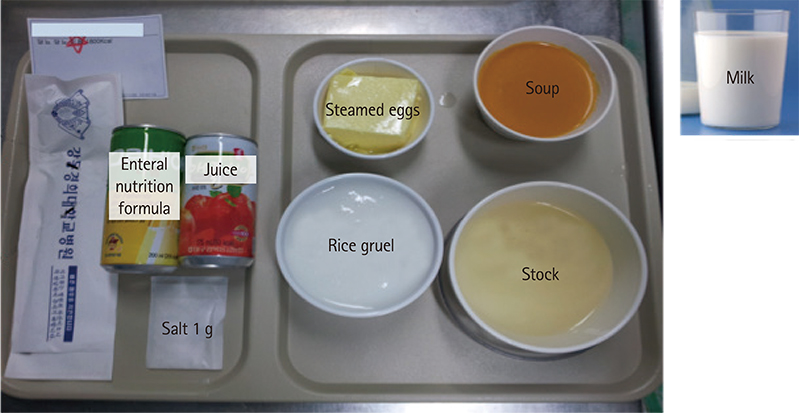Clin Nutr Res.
2015 Jan;4(1):63-67. 10.7762/cnr.2015.4.1.63.
Nutritional Intervention Using Nutrition Care Process in a Malnourished Patient with Chemotherapy Side Effects
- Affiliations
-
- 1Nutrition Team, Kyung Hee University Hospital at Gangdong, Seoul 134-727, Korea. hye0221@khnmc.or.kr
- KMID: 2049164
- DOI: http://doi.org/10.7762/cnr.2015.4.1.63
Abstract
- In this case study, the process of nutritional diagnosis and intervention conducted at a hospital on a malnourished patient who underwent treatment for a chronic illness (chemotherapy for cancer treatment) was recorded. The patient received his first round of chemotherapy for colorectal cancer, and then a second round after the cancer metastasized to the liver. The patient was malnourished and had experienced weight loss (17% loss in the most recent 3 months) due to side effects of chemotherapy including stomatitis, nausea, and vomiting. Nutritional diagnosis and intervention via the nutrition care process were implemented through two screening rounds, and the quantity of oral intake increased from 28% to 62% of the recommended daily intake. The patient required continuous monitoring and outpatient care after hospital discharge. It is speculated that if a more active patient education and dietary regimen with respect to chemotherapy side effects had been offered after the patient's first chemotherapy cycle, it might have been possible to treat ingestion problems due to stomatitis during the second cycle of chemotherapy and prevent the weight loss. Henceforth, patients receiving chemotherapy should be educated about nutrition management methods and monitored continuously to prevent malnutrition.
MeSH Terms
Figure
Reference
-
1. Oh BJ. General oncology nursing. Seoul: Shin-Kwang Press;2005.2. Yang YH, Lee DS. The relationship of anorexia, nausea, vomiting, oral intake and nutritional status in patients receiving chemotherapy. J Korean Acad Nurs. 2000; 30:720–730.
Article3. Pérez Camargo DA, De Nicola Delfín L, Ñamendys-Silva SA, Copca Mendoza ET, Hernández Méndez M, Herrera Gómez Á, Meneses García A. Nutritional status of patients with cancer of oral cavity. Nutr Hosp. 2013; 28:1458–1462.4. Escott-Stump S. Section 13. Cancer. Nutrition and diagnosis-related care. 6th ed. Philadelphia (PA): Wolters Kluwer/Lippincott Williams & Wilkins;2008. p. 672–688.5. Boullata JI, Carney LN, Guenter P. American Society for Parenteral and Enteral Nutrition. A.S.P.E.N. enteral nutrition handbook. Silver Spring (MD): American Society for Parenteral and Enteral Nutrition;2010.6. Ottery FD. Patient generated subjective global assessment. In : McCallum PD, Polisena CG, editors. The clinical guide to oncology nutrition. Chicago (IL): American Dietetic Association;2000. p. 11–23.7. Park KO, Choi-Kwon S. Effects of individualized nutritional education programs on the level of nutrient intake and nutritional status of colorectal cancer patients undergoing palliative chemotherapy. J Korean Acad Nurs. 2012; 42:799–809.
Article8. Poulsen GM, Pedersen LL, Osterlind K, Bæksgaard L, Andersen JR. Randomized trial of the effects of individual nutritional counseling in cancer patients. Clin Nutr. 2013; Forthcoming.
- Full Text Links
- Actions
-
Cited
- CITED
-
- Close
- Share
- Similar articles
-
- Nutrition Care Process and Diabetes: Focus on Nutrition Diagnosis
- Nutrition Management for Cancer Patients
- Analysis of the Factors Relating Nutritional Status in Discharging of Leukemia Patients Receiving Chemotherapy
- Nutritional Intervention Process for a Patient with Kidney Transplantation: a Case Report
- The Relationship of Anorexia, Nausea, Vomiting, Oral Intake and Nutritional Status in Patients Receiving Chemotherapy



